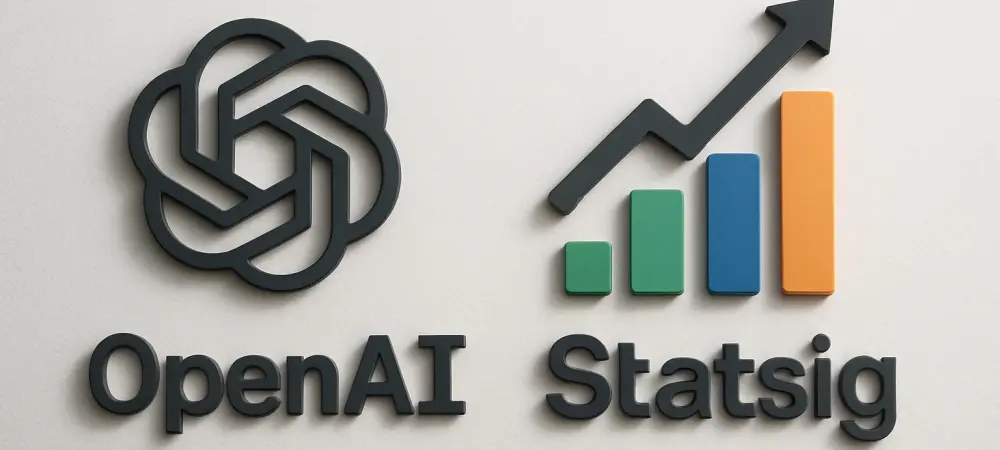In a landscape where artificial intelligence is reshaping industries at an unprecedented pace, strategic maneuvers by leading players can redefine market dynamics overnight. OpenAI, a frontrunner in generative AI, has made a bold move with its $1.1 billion acquisition of Statsig, a Washington-based product development platform. This deal, announced recently, is not just a financial transaction but a calculated step to solidify OpenAI’s position in a fiercely competitive field. With the AI market projected to see explosive growth— AI assistant revenue expected to surge from $3.35 billion to $21.11 billion by 2030, and AI development tool software revenue climbing from $9.76 billion to $12.99 billion in the same period—this acquisition signals OpenAI’s intent to outpace rivals. The integration of Statsig’s cutting-edge tools promises to enhance the speed and precision of product development, potentially setting a new standard in the industry.
Accelerating AI Product Development
Harnessing Real-Time Experimentation Tools
The core of Statsig’s value lies in its real-time experimentation and feature flagging capabilities, which are set to revolutionize how OpenAI iterates on its generative AI products. These tools enable rapid testing and refinement of features, ensuring that updates to platforms like ChatGPT and Codex can be rolled out with minimal risk and maximum efficiency. By embedding such technology, OpenAI can drastically cut down the time-to-market for new features, a critical advantage in an industry where delays can cede ground to competitors like Google’s Gemini or Anthropic’s Claude. According to industry analysts, this capability provides a structured, data-driven approach to innovation, something that reportedly sets OpenAI apart from others in the space. The ability to measure user responses in real time and adjust accordingly means that product enhancements are not just faster but also more aligned with market needs, offering a tailored user experience that could redefine customer expectations in the AI sector.
Reducing Development Cycles for Competitive Edge
Beyond the immediate benefits of experimentation, the acquisition is poised to compress OpenAI’s overall development cycles, a factor that could prove decisive in maintaining market leadership. In a field where speed often trumps perfection, the integration of Statsig’s infrastructure allows for continuous deployment and iteration without sacrificing stability. This means that while competitors may struggle with lengthy testing phases, OpenAI can push updates and new functionalities at a brisk pace, responding to user feedback and market trends almost instantaneously. Such agility is particularly crucial as the AI landscape becomes increasingly crowded with players like AWS introducing solutions such as Amazon Q and Kiro. The strategic use of Statsig’s platform ensures that OpenAI not only keeps up with but potentially outmaneuvers these rivals by delivering refined products faster, securing a foothold in emerging niches within the AI ecosystem and capitalizing on first-mover advantages.
Strategic Integration and Market Positioning
Leadership Synergy and Structural Alignment
A significant aspect of this acquisition is the seamless integration of Statsig’s leadership into OpenAI’s hierarchy, signaling a focus on synergy and long-term growth. Statsig’s CEO, Vijaye Raji, steps into the role of CTO of Applications, a newly created division under OpenAI, reporting through Fidji Simo to CEO Sam Altman. With Raji’s extensive background in large-scale consumer engineering from his time at Meta, his oversight of product engineering for key offerings like ChatGPT and Codex is expected to bring a fresh perspective to core systems and infrastructure. This leadership transition is complemented by a cautious approach to incorporating Statsig’s staff, who will continue serving existing customers from Seattle while gradually aligning with OpenAI’s broader objectives. This measured integration reflects a commitment to maintaining operational continuity and ensuring that the expertise brought by Statsig enhances rather than disrupts OpenAI’s ongoing projects.
Bolstering Innovation Amidst Rising Competition
The acquisition also underscores OpenAI’s relentless push for innovation, as evidenced by recent updates to its flagship products, which now include ChatGPT’s access to GPT-5 and Codex’s enhancements like a new IDE extension and improved command-line interface. These advancements highlight a proactive stance in a market teeming with competition, where staying relevant demands constant evolution. By leveraging Statsig’s tools, OpenAI can further refine these offerings, ensuring that each update is not just a response to user needs but a step ahead of competitor capabilities. The strategic necessity of this deal becomes evident when considering the aggressive moves by other industry giants, each vying for a larger share of a booming market. Statsig’s data-driven framework provides OpenAI with the precision to iterate effectively, positioning it to potentially outstrip rivals who may lack comparable agility in product development, thus fortifying its standing in the AI arena.
Reflecting on a Game-Changing Move
Looking back, OpenAI’s acquisition of Statsig for $1.1 billion marked a pivotal moment in the evolution of generative AI, reflecting a deliberate strategy to enhance product launches and refine existing applications. The integration of Statsig’s real-time tools and the thoughtful alignment of leadership and staff underscored a balanced approach to growth. As the dust settled on this deal, it became clear that the focus was on building a robust framework for rapid, data-driven iteration, which had already begun to influence the pace of updates to platforms like ChatGPT. Moving forward, the industry should monitor how this synergy translates into tangible market gains, particularly in outpacing competitors. Stakeholders might consider exploring similar strategic partnerships to bolster their own innovation pipelines, ensuring they remain agile in a landscape where technological prowess and strategic foresight are paramount for sustained success.

